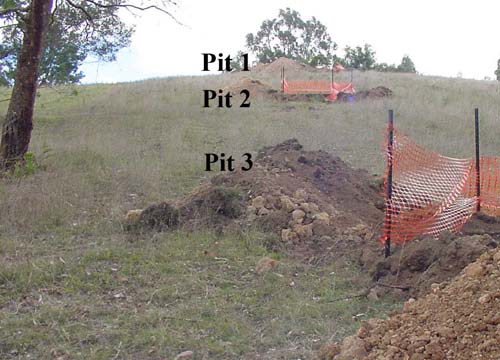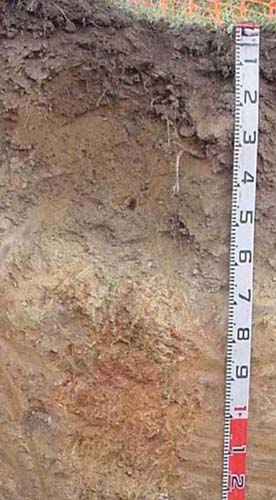EGS265
Location: Wiseleigh
Australian Soil Classification: Sodic, Magnesic (and Dystrophic), Brown DERMOSOL
Map Unit: Tambo (Component 3)
Previous Site Name: EG265
General Landscape Description: Gently undulating plain.
Site description: Lower south-south east slope, 12%
Land Use: Grazing
Native Vegetation: Shrubby dry forest
Geology: Colluvium derived from further up-slope

Sequence of soil pits examined at Wiseleigh
Soil Profile Morphology:
Surface Soil
| A11 | 0 – 10 cm | Very dark grey (7.5YR3/1); loam; moderate fine subangular blocky structure; firm consistence dry; clear change to: |  EG265 Profile |
| A12 | 10 – 55 cm | Dark brown (7.5YR3/2); fine sandy light clay; moderate fine subangular blocky structure; firm consistence dry; clear change to: | |
| A2 | 55 – 65 cm | Light yellowish brown (10YR6/4); fine sandy clay loam; massive; very firm consistence dry; few (2-10%) angular quartz gravel (6-20 mm); clear change to: | |
| Subsoil | |||
| B2 | 65 – 85 cm | Yellowish red (5YR4/6); fine sandy clay loam; moderate coarse (50 – 100 mm) angular blocky structure; strong consistence dry; few (2-10%) angular quartz gravel (6-20 mm); clear change to: | |
| C1 | 85 – 120 cm | Yellowish red (5YR4/6); fine sandy light clay; weak fine angular blocky structure; very firm consistence dry; few (2-10%) angular quartz gravel (6-20 mm); gradual change to: | |
| C2 | 1.2 – 1.9 m | Pale brown (10YR6/3); light clay; strong medium (10 – 20 mm) polyhedral structure; very firm consistence dry; diffuse change to: | |
| C3 | 1.9 – 2.4 m | Dark reddish grey (5YR4/2); light medium clay; few (2-10%) angular quartz gravel (6-60 mm). |
Key Profile Features:
- Deep dark coloured surface horizons indicate a high organic matter content and high water retention properties.
- It is likely much of the surface soil has been derived from further upslope post-clearing.
Soil Profile Characteristics:
Surface soil (A11) | Very strongly acid | Non-sodic | - |
Subsoil (B2 horizon) | Slightly acid | Non-sodic | Moderate1 |
Deep subsoil (C2 horizon) | Slightly alkaline | Sodic | Strong |
Chemical and Physical Analysis:
Horizon | Horizon Depth (cm) | pH (water) | pH CaCl2 | CE dS/m | Organic Carbon % | Total Nitrogen % | Exch. Al | Exch. Acididty meq/100g | Exchangeable Cations | Coarse Sand (0.2-2.0 mm) % | Fine Sand (0.02-0.2 mm) % | Silt (0.002-0.02 mm) % | Clay (<0.002 mm) % | Field cap. % w/w | Wilt. point % w/w | |||
Ca | Mg | K | Na | |||||||||||||||
meq/100g | ||||||||||||||||||
A11 | 0-10 | 5.1 | 4.4 | 0.08 | 9.2 | 0.54 | 26 | 21 | 3.6 | 3.2 | 0.1 | 0.5 | 23 | 24 | 21 | 18 | 44.7 | 23.2 |
A12 | 10-55 | 5.4 | 4.5 | <0.05 | 3.5 | 0.16 | 230 | 21 | 0.6 | 0.9 | 0.3 | 0.1 | 18 | 28 | 7 | 39 | 42.9 | 12.5 |
A2 | 55-65 | 6 | 4.8 | <0.05 | 63 | 6 | <0.1 | 0.9 | <0.1 | 0.1 | 25 | 34 | 21 | 18 | 21 | 8.1 | ||
B2 | 65-85 | 6.2 | 4.9 | <0.05 | 36 | 4.6 | <0.1 | 1.9 | <0.1 | 0.3 | 24 | 30 | 21 | 23 | 20.3 | 9.2 | ||
C1 | 85-120 | 6.6 | 5.1 | 0.05 | 210 | 3.5 | <0.1 | 2.3 | 0.4 | 0.2 | 21 | 27 | 19 | 33 | 25.9 | 11.5 | ||
C2 | 120-190 | 7.7 | 6.1 | 0.06 | <5 | 2.1 | <0.1 | 2.9 | <0.1 | 0.7 | 23 | 29 | 18 | 30 | 22.8 | 9.6 | ||
C3 | 190-240 | 8 | 6.8 | 0.2 | 3.4 | 0.3 | 4.9 | 0.2 | 1.9 | 18 | 21 | 14 | 45 | 30.1 | 15.4 | |||
Management Considerations
Whole profile
- On the assumption the roots can extract the water in the top 65 cm of the soil, the plant available water capacity is estimated at 68 mm. The high amounts of organic matter in this surface soil have added to the soil’s ability to retain water.
Surface (A) horizons
- The surface soil is very strongly acidic and the high levels of exchangeable aluminium occurring in the subsurface soil are likely to restrict the growth of aluminium sensitive species. A response to lime may be expected, but before it is applied, test strips should be used to evaluate the cost/benefit.
- Potassium is deficient and a response to potassium fertiliser is likely. This would particularly apply if the pasture was removed and baled.
- The nutrient holding capacity of the immediate surface soil is low to moderate (based on the sum of the basic cations) largely due to its high organic matter content. The immediate subsurface soil has an extremely low nutrient holding capacity.
Subsoil (B) horizons
- Based on the sum of the basic cations, the subsoil has an extremely low nutrient holding capacity.
Deep subsoil (C) horizons
- The deep subsoils are sodic and strongly dispersive. If the soil becomes saturated there is the risk of deep tunnels and subsequent gully erosion.
Profile Described By: Ian Sargeant (2011).


